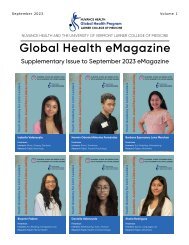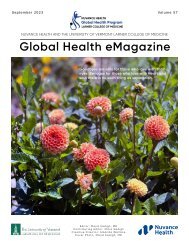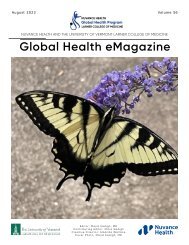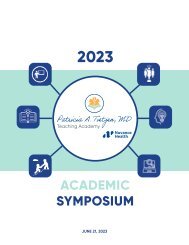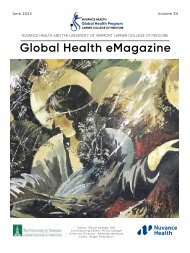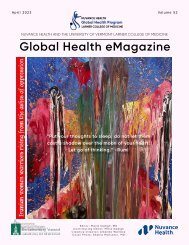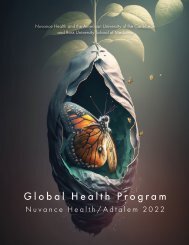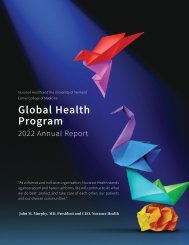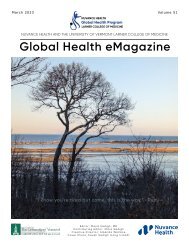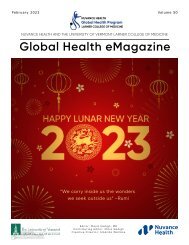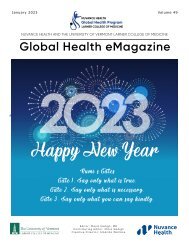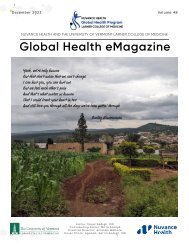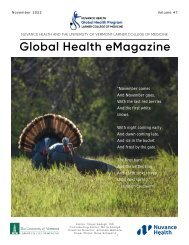eMagazine July 2023
Create successful ePaper yourself
Turn your PDF publications into a flip-book with our unique Google optimized e-Paper software.
OUR PEOPLE,<br />
OUR MISSION<br />
Global Health<br />
<strong>eMagazine</strong><br />
<strong>July</strong> <strong>2023</strong><br />
Highlights<br />
Among the Letters<br />
Reflections<br />
Hispanic and Latinx Voices<br />
Global Local<br />
Art to Remind Us of Who We<br />
Can Be<br />
Our Beautiful Planet<br />
Voices of Ugandan<br />
Students<br />
Nursing Division<br />
Congratulations<br />
Video of the Month<br />
Article of the Month<br />
Calendar<br />
Global Health Family<br />
Photo News<br />
Resources<br />
Previous Issues of<br />
the <strong>eMagazine</strong><br />
However, there is a huge opportunity to curb this potential disaster–the youth.<br />
Given that Africa has the youngest population in the world, focusing on this<br />
demographic is key. Today, more than one-third, or about 360 million Africans,<br />
are young people between the ages of 10 and 24. By 2050, when they reach<br />
45 and older—the time when NCD risks are highest—the population in Africa<br />
will be three times its current size. Without taking any action, this large cohort<br />
will be further burdened by NCDs because the risk behaviors mentioned earlier<br />
are on the rise among young people today. Together, adolescence and young<br />
adulthood represent a period of experimentation and identity formation, and<br />
also a time when lifelong behavior patterns are typically initiated or established.<br />
The World Health Organization (WHO) estimates that 70 percent of premature<br />
deaths in adults worldwide are the result of behaviors begun in adolescence.<br />
Thus, interventions that tackle the social and economic precursors of NCD<br />
risks, encourage positive health behaviors, and discourage negative ones in<br />
young people can significantly shift the projected trajectory of NCDs in Africa.<br />
Positive behaviors established during childhood or adolescence, such as<br />
healthy eating and regular exercise, are more likely to be carried through to<br />
adulthood. In contrast, the earlier people begin using harmful substances such<br />
as alcohol, the greater the risk of abuse and dependence later in life. Typically,<br />
when unhealthy behaviors persist into adulthood, they become difficult to<br />
change. This is particularly important in Uganda, having such a significant<br />
youth population. In fact, according to the latest State of Uganda Population<br />
Report 2012 released in December, Uganda has the youngest population in the<br />
world, with over 78% below the age of 30 years. This presents both a unique<br />
challenge but also an unusual opportunity in fighting the NCD burden. In<br />
Uganda, research has shown a high prevalence of NCD risk behaviors among<br />
University students (Nyombi et al., 2016).<br />
As the NCD MAK chapter, we have proposed and embarked on several projects<br />
to utilize this opportunity and target the young population. We believe more<br />
in preventative than curative strategies. Among the many endeavors we<br />
proposed, a picture book that raises awareness about NCD risk factors and<br />
their prevention could be especially effective. This book would be written in<br />
simple language and illustrated with engaging pictures to make it appealing<br />
and easy to understand for adolescents. The book should cover topics such<br />
as healthy eating, physical activity, avoiding tobacco and alcohol, and stress<br />
management. The books could be distributed to primary and secondary<br />
schools in Central Uganda to children aged 10 to 14 years. Furthermore,<br />
education sessions targeting 15 to 19 year olds by trained facilitators with<br />
interactive and engaging teaching methods for retention of material could be<br />
conducted in secondary schools and at adolescent clinics in Mulago Hospital.<br />
These among others are some of the projects we are doing in our capacity as<br />
medical students to remedy this growing problem.<br />
31




